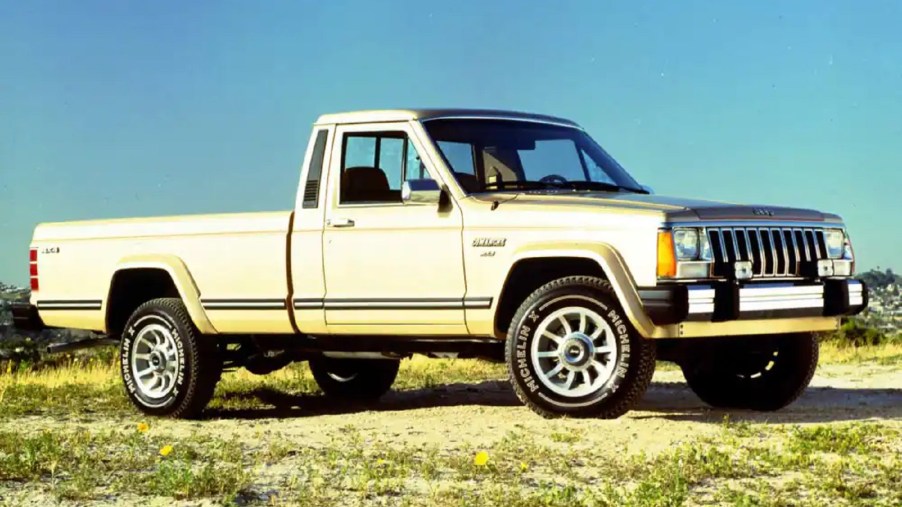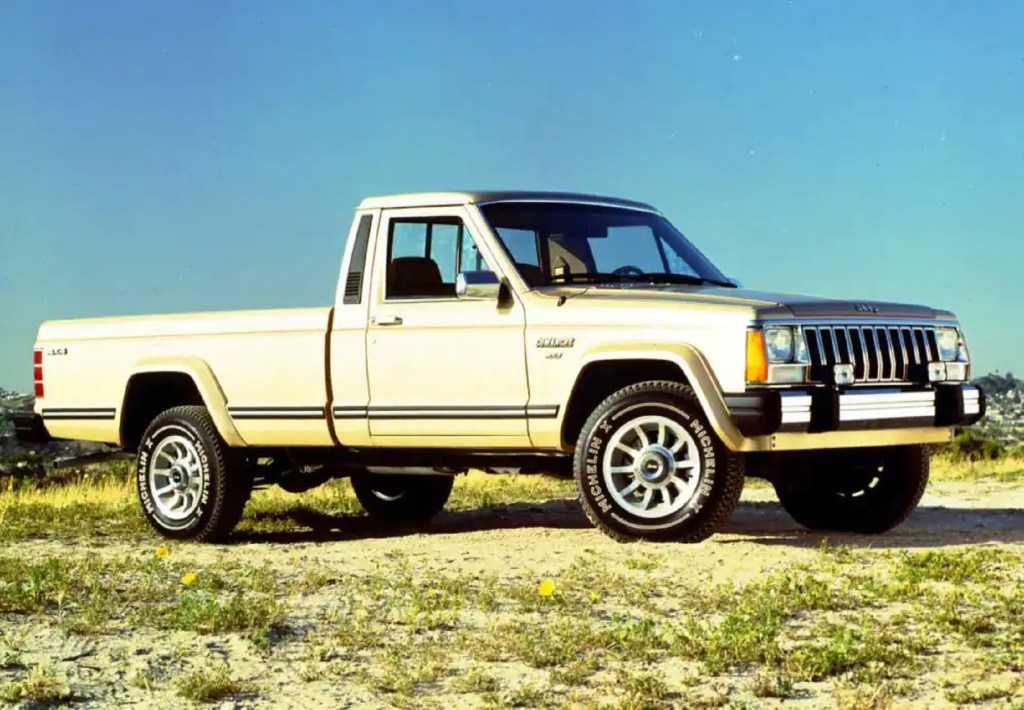
Why Is the Jeep Comanche Worth Less Than the Jeep J10?
It’s not just modern Jeeps like the Wrangler that hold their value over time. As is the case with many other classic SUVs and trucks, vintage Jeeps have either maintained or increased their values in the last few years. However, not all the brand’s past models have appreciated equally. For example, while the Jeep J10 is on the rise, especially the Golden Eagle versions, the Jeep Comanche is relatively cheap in comparison. But why is that?
Until the Gladiator arrived, the XJ Cherokee-based Jeep Comanche was the brand’s last pickup truck

Before the modern Gladiator arrived, Jeep fans thought that the brand might be done with pickup trucks for good. That’s because Jeep hadn’t offered a truck since 1992. And that penultimate truck was the 1986-1992 Jeep Comanche.
Jeep built the J10 and the other J-Series/Gladiator trucks on the same platform as the SJ Wagoneer. And it did something similar with the Comanche, Hagerty explains. Only instead of using the Grand Wagoneer—still in production in 1986—Jeep chose the then-new XJ Cherokee as a base. So, like the modern Ford Maverick, the ‘MJ’ Jeep Comanche is a unibody pickup truck. And it competed with the likes of the original Ford Ranger, which was the Maverick of its day.
However, Jeep managed to sneak a bit of the Wagoneer into the Comanche. Specifically, the rear half. Although the Comanche’s front half is unibody like the XJ, its rear half is based on the Wagoneer’s frame, Road & Track explains. Hence why, depending on the bed length and engine choice, the truck has up to a 2205-lb payload capacity. The 2021 Ranger can’t even carry that much.
However, the Jeep Comanche inherited more from the XJ Cherokee than just its platform. Firstly, it looks, well, like an XJ Cherokee with a bed. Given that XJs and SJs are appreciating because of their style, that’s arguably a good thing.
But while the XJ Cherokee became popular for its blend of luxury and capability, the Comanche occupied a more awkward middle-ground between utilitarian and luxurious. That might be why, compared to the older-school Jeep J10 in its day, the Comanche wasn’t as popular in the 1980s. However, these same attributes are what make it a solid pickup truck even today.
It doesn’t have a J10 image, but the Jeep Comanche isn’t lacking in on- or off-road capability—racing included
As it’s based (partially) on the XJ Cherokee, the Jeep Comanche has solid axles, 4WD with a two-speed transfer case, and locking hubs. As a result, this ‘80s truck makes a solid rock-crawler, especially with a few choice mods. However, there was a RWD model available, as well as two different-length beds.
In addition, Jeep offered the Comanche with a myriad of engine options, including a 2.5-liter fuel-injected four-cylinder, 2.1-liter turbodiesel four-cylinder, and GM’s 2.8-liter V6. Plus, you could pair these engines with either a three- or four-speed automatic or a five-speed manual. The 2.5-liter Comanches only made about 117 hp, but they still won first and third places in the 1988 SCCA RaceTruck Challenge, Hagerty reports.
It’s worth remembering that this racing series competed on paved tracks, not just in the desert. But then, that’s the advantage of the Comanche’s odd body: it’s stiffer than you’d expect. Upgrade the sway bars, tweak the suspension, and fit better brakes, and you can genuinely autocross this old truck, R&T says, Yet even in stock form, it handles surprisingly well for an ‘80s truck.
If you do plan on off-roading or autocross a Jeep Comanche, hold out for a 1987-or-later model. That’s the year Jeep gave the truck the brand’s famously-durable 4.0-liter inline-six. It started off with 173 hp and 220 lb-ft of torque, but by 1992 it made 190 and 225 lb-ft of torque. And it wasn’t just fuel-efficient, powerful, and torquey—it sounded great, too, Hagerty notes.
Admittedly, the Jeep Comanche isn’t exactly luxurious by modern standards. But it does have things like power steering, power brakes, and a bench seat. And anyway, that’s the appeal of pickup trucks from this era: rugged, honest simplicity.
The ‘80s Cherokee pickup truck still trails behind the ‘70s Wagoneer one in market value…for now
Unfortunately, as noted earlier, although the Comanche is based on the XJ Cherokee, it’s not quite as luxurious as the SUV. As a result, while Jeep sold about 2.9 million XJs, it only sold about 200,000 Comanches, Hagerty reports. And while parts of this Jeep pickup are well-known for their durability, the truck as an entity doesn’t have the same indestructible reputation as, say, a ‘90s Toyota Pickup. So, it’s not as valuable as the Toyota or the Jeep J10.
But that is a boon for potential truck shoppers. You can grab a pristine late-model Jeep Comanche 4×4 for $30,000. That’s 50% lower than the price of an equivalent Jeep J10, Hagerty says. And good-to-excellent models are even cheaper; you can pick one up for $10,000-$20,000.
So, it doesn’t have the same reputation and looks as the J10, but that does mean that the Jeep Comanche is arguably an ‘80s truck diamond in the rough. At least, for now.
Follow more updates from MotorBiscuit on our Facebook page.


